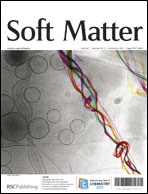Effects of crystalline subunit size on silk fiber mechanics†
Abstract
Here, we utilize a computational bottom-up approach to decipher the size effects of poly(alanine) crystalline subunits as they occur in most spider silks on silk fiber mechanics. We vary the crystal size in terms of their cross-sectional area, i.e. the number of layers of β-strands, S, in the crystal and the backbone length along the fiber axis, N. Meanwhile, other major parameters such as chemical composition, fiber crystallinity, and the relative orientation of the crystals in the fiber are constrained. The computational approach incorporates Molecular Dynamics and Finite Element simulations of the crystalline subunits along with Finite Element simulations of a two phase silk fiber model in order to determine the stress–strain behavior, elastic moduli and toughness properties. Overall, the fiber elastic modulus and toughness increase with the length of the crystals as given by the number of residues in the β-strands (N), and decrease with the crystal cross-section area, i.e. the number of β-strands per crystal (S). The smallest cross-sectional area investigated, a 3 × 3 crystal (∼1 nm2), shows the highest sensitivity of the mechanical properties towards the crystal length. The presented approach is a versatile tool in artificial fiber design since it does not require any empirical parameters and it is similarly applicable to other semicrystalline polymeric systems or composite materials.


 Please wait while we load your content...
Please wait while we load your content...